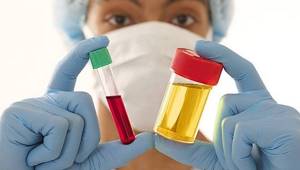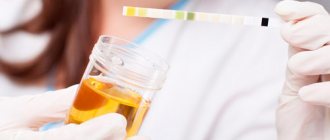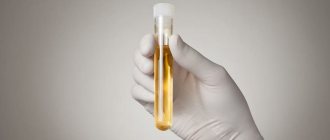Synonyms: Creatinine (in urine), Creatinine.
Urinalysis for creatinine is widely used in the diagnosis of diseases of the urinary system and to monitor treatment. Typically, this test is performed as part of a comprehensive kidney function test in conjunction with urine protein, such as albumin. But it has the greatest diagnostic value as part of the Rehberg test, during which the clearance (glomerular filtration rate) of endogenous creatinine is determined.
General information
Creatinine is formed in muscle tissue during the breakdown of creatine phosphate and creatine. Their metabolism is carried out regularly and stably, as a result of which muscle fibers receive the energy necessary for functioning (contraction). Creatinine then travels to the kidneys, where it is filtered and excreted in the urine. At the same time, its reabsorption in the renal tubules (reabsorption) is minimal.
In the case of normal functioning of the glomeruli of the kidneys, the body maintains a safe and stable level of creatinine. As the child grows and develops, creatinine increases, which is due to high energy costs for the formation of muscle tissue. Also for men, the norm for this indicator is higher, since physiologically their body requires more energy to increase muscle area.
If the concentration of creatinine changes sharply, then a disorder of the kidneys and urinary system should be suspected. In addition, deviations from the norm may indicate malnutrition, the development of cancer and autoimmune processes, and infection. Therefore, to obtain a reliable picture of the disease and determine a specific pathology, a comprehensive study of creatinine (in the blood and in the urine at the same time) is carried out - the Rehberg test.
What is creatinine and how is it excreted from the body?
During the metabolism of proteins in the body, creatine is formed, which is involved in the synthesis of the main energy molecule - ATP. During these reactions, creatinine is released, a toxic substance that must be removed from the body.
The disposal of this breakdown product is carried out by the kidneys, where it enters with the blood flow through the renal arteries. The main structural and functional element of the kidneys is the nephron. The process of urine formation occurs in it, which includes two stages:
- Filtration. Filtration occurs in the glomeruli formed by a network of capillaries. The glomerulus is surrounded by a capsule, between the walls of which there is a gap and the glomerulus. Due to the pressure difference, plasma rich in low-molecular substances, including creatinine, comes out of the capillaries here. This is how primary urine is formed, which produces up to 150 liters per day.
- Reabsorption. The plasma then moves through the renal tubular system, where reabsorption occurs. Water with useful substances dissolved in it (glucose, amino acids) from primary urine enters back into the blood. At the same time, numerous toxins additionally enter the tubules from the blood vessels. This is how secondary urine is formed (on average 1.5 liters per day). It contains “waste” - creatinine, uric acid, urea, ketone bodies, etc. They are excreted from the body in the urine.
If the filtration and/or reabsorption processes are disrupted, some of the harmful substances remain in the body, leading to serious poisoning.
Indications
Assessment of the condition and functioning of the renal filtration apparatus.
Acute or chronic kidney disease:
- pyelonephritis (inflammation of the kidney pelvis);
- renal failure of various forms and stages;
- glomerulonephritis (damage to the glomeruli).
Pathologies associated with metabolic disorders (diabetes mellitus).
Thyroid dysfunction (hypo- and hyperthyroidism).
Infectious, bacterial, viral processes in acute and chronic form.
Arterial hypertension.
Autoimmune disorders:
- lupus erythematosus (connective tissue damage);
- vasculitis (damage to vascular walls), etc.
Evaluation of the effectiveness of therapy for kidney diseases.
Preventive examination of patients with unfavorable heredity.
Screening before and after surgery on the genitourinary system.
Assessment of the quality of collection of biomaterial (daily urine) for other laboratory tests (for example, for hormonal studies).
Monitoring the course of complicated pregnancy.
Diagnosis of cancer pathologies.
Patient complaints about:
- discomfort, pain and burning when urinating;
- presence of impurities of blood, pus, mucus in the urine;
- feeling of incomplete emptying of the bladder;
- increased frequency of urination, false urges;
- sharp and nagging pain in the lumbar region;
- swelling of the tissues of the face, legs, etc.
The results of an analysis for creatinine in daily urine can be deciphered by: a nephrologist, urologist, endocrinologist, therapist, pediatrician, family doctor.
Creatinine clearance
The Rehberg test is the most important diagnostic test that allows you to evaluate kidney function. To carry it out, a 24-hour urine test and a blood test for creatinine levels are required. Next, using a special formula, the rate of its elimination from the body is calculated, which characterizes the glomerular filtration rate in ml/min.
Normal clearance values:
- in middle-aged men 80-140 ml/min;
- in women – from 70 to 120 ml/min.;
- in children under 18 years of age – 65-100 ml/min.
In the initial stages of hypertension and diabetes mellitus, the glomerular filtration rate increases; in renal failure, on the contrary, it drops to 20-40 ml/min.

A clearance test is required for patients suffering from kidney disease, pregnant women, and hypertensive patients in a hospital setting.
Creatinine in urine is normal
| Patient's gender (age over 14 years) | Creatinine in urine, mmol/day |
| Male | 7,1 – 17,7 |
| Female | 5,3 – 15,9 |
Factors of influence
- An illiterate menu: if meat food predominates, creatinine increases, if the patient is a vegetarian, it decreases;
- Violation of the rules for preparing for analysis, collecting or storing daily urine;
- Physical activity on the day of material collection (increases the value);
- Inability to cancel a course of treatment with drugs that affect kidney function;
- Pregnancy (creatinine may increase slightly);
- Taking diuretics (lowers readings).
Decoding the results: norms
This test is part of a comprehensive kidney examination. The rate of creatinine in urine depends on a person’s gender, age, weight, physique, and physical activity, since its level in the body is determined by muscle mass and the rate of protein metabolism.
Men
Normal values for men are considered to be values from 7 to 18 mmol/day. They may change during the day, but in a healthy person they do not go beyond normal limits.
Creatine in the urine of men 20-50 years old depends on lifestyle: with significant physical activity, good nutrition with a predominance of protein foods, its amount in the urine is higher than in people leading a passive life.
Teenagers have less muscle mass than adults, and therefore the amount of this substance in the urine is lower. On average, in 16-18 year old boys it is 2-5 mmol/day. With advancing age, muscle mass and physical activity decline, and so do creatinine levels.
Women
Skeletal muscles in women are less developed than in men. Therefore, the level of creatinine in the urine of women is much lower: normal values for them are 5.5-16 mmol/day.
In teenage girls, these values are even lower and correspond to the norms in boys (2-5 mmol/day). In women after 60 years of age they also decrease.
Pregnant
Changes in the hormonal status of a pregnant woman affect the excretory function of the kidneys, so the concentration of creatinine in the urine usually decreases. The second reason for the decrease in this indicator is the increase in the total volume of fluid in the body during pregnancy.
An increase in fluid volume indicates an increased load on the kidneys, which is manifested by edema.
Children
In children, muscle mass gradually increases with age, and creatinine in the urine increases accordingly, and no differences are observed in girls and boys.
In the first year of life, the content of this substance increases from 1 to 2 mmol/day, in the next 10-12 years it increases to 3.5 mmol/day, and by the age of 18 it reaches 2.5-5 mmol/day.
A significant increase in creatinine levels in a child indicates renal pathology; a decrease indicates degenerative changes in the body.
Lowering values
- Renal dysfunction, renal failure;
- Kidney diseases (pyelonephritis, glomerulonephritis), amyloidosis (pathological accumulation of starch), etc.;
- Hyperthyroidism (excess thyroid hormones);
- Anemia (anemia) of various etiologies;
- Muscular dystrophy;
- Muscle paralysis;
- Neurogenic atrophy (critical reduction in the size of muscle fibers);
- Polymyositis (generalized muscle damage);
- Myositis (inflammation of muscle tissue);
- Stenosis (narrowing of the lumen) of the renal artery;
- Leukemia (blood cancer);
- Radiation sickness (a pathology that develops as a result of exposure to radioactive radiation).
Reasons for increased creatinine
If the level of creatinine in the urine is increased, this means that its formation in the skeletal muscles has increased. High creatinine may indicate both the presence of serious pathologies and lifestyle changes.
Normally, this indicator may increase as a result of:
- increasing muscle mass during training, with heavy physical exertion;
- consuming large amounts of protein foods;
- long-term uncontrolled use of antibiotics, hormones, anti-inflammatory drugs;
- dehydration of the body.
In such situations, patients are prescribed a diet low in meat products and are advised to adjust their drinking regime.
An increase in creatinine in urine in most cases is caused by:
- kidney inflammation (glomerulonephritis, pyelonephritis);
- renal failure;
- metabolic disorders in diseases of the endocrine glands (diabetes, hypothyroidism);
- injuries with damage to muscle fibers;
- malignant neoplasms.

If the analysis shows an increase in the level of this metabolite in the urine, a serious examination is necessary to determine the causes of the deviation.
Preparing for analysis
Diet requirements:
- 2-3 days in advance you must stop drinking alcohol and energy drinks;
- within 24 hours, spices, marinades, pickles and “coloring” vegetables are removed from the diet: cranberries, blueberries, beets, mulberries, carrots, etc.;
- At the same time, it is advisable not to consume diuretic products (watermelon, lingonberry leaf decoction, etc.).
Requirements for taking medications:
- 1-2 days before the test, it is forbidden to take diuretics;
- also, a few days before collecting urine, you need to limit the intake of drugs that can affect the functioning of the kidneys in general (corticosteroids, vitamin C, cytostatics, etc.);
On the day of collection of biomaterial:
- you need to protect yourself from all kinds of physical and emotional stress;
- smoking is not advisable;
- The test is not performed during menstrual bleeding.
Rules for collecting daily urine
- Night urine (the first urge in the morning, usually from 6.00 to 8.00) is not collected.
- Subsequent urinations are carried out in a clean container with a volume of 2-3 liters. The last portion of urine is collected at 6-8 am the next day. Before each urination, it is necessary to hygienically wash the genitals with neutral soap and boiled water.
- The container with biomaterial should be stored in the refrigerator at 4-8°C.
- At the end of urine collection, measure the entire daily volume and thoroughly mix (shake) the biomaterial.
- Pour 40 ml of urine into a sterile container, indicate your data on it (full name, age, date of collection, daily urine volume) and send the material to the laboratory within 2 hours.
Other urine tests
- Uric acid in urine
- Urea in urine
- Creatinine in urine
- Rehberg's test
- Blood in urine
- Free cortisol in urine
- Protein in urine
- General urine test during pregnancy
What does it mean if the indicator is lowered
If there is a decrease in creatinine levels in a urine test, first of all, pay attention to the patient’s physical condition. The low rate may be due to:
- sedentary lifestyle;
- lack of protein products in the diet;
- anorexia;
- pregnancy;
- taking anabolic steroids and diuretics.
Its content in urine decreases in cases of anemia, paralysis of the limbs, leukemia, chronic liver pathologies, and heart rhythm disturbances.









